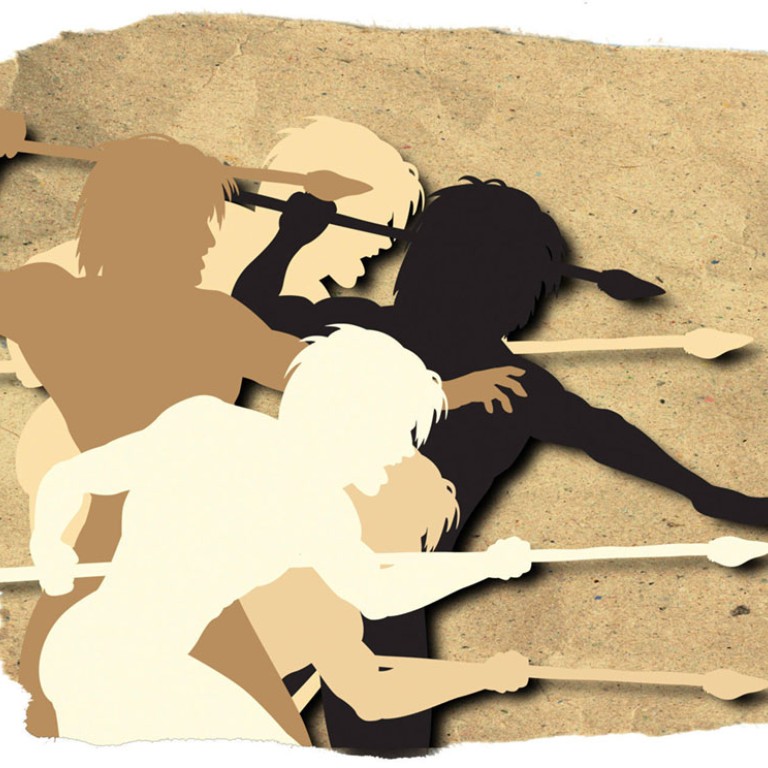
Men and violence - how they size up one another and why numbers count
Foes grow larger if you're alone or they have a handgun, but shrink if you're in a group, say studies with implications for police and armies
Daniel Fessler is at the University of California Los Angeles' Drake Track Stadium to do a bit of discreet academic observation.
It's autumn 2013. Headlines are fading about a jury's acquittal of a neighbourhood watch volunteer who killed an unarmed black teenager, Trayvon Martin, in the US state of Florida. Just about no one outside the US state of Missouri has even heard of the city of Ferguson.
But Fessler, an associate professor of anthropology at the university, believes he's uncovering a crude mental shortcut that may shed light on the confrontations in both places and help explain why men resort to violence.
First, his undergraduate research assistants will have to lure male students into doing a strange bit of exercise for US$3. Each volunteer will climb up and down the stadium stairs while holding an electronic metronome and walking to its beat. He'll do this alongside another student whose metronome may or may not be in sync with his.
Then they fill in a questionnaire about "the links between motor exertion, visual perception and visual intuition". Fessler wants to see how tall or strong the volunteer imagines a "convicted criminal" is.
He expects that those who walked in synchrony with another person will pair the face with smaller, less muscular bodies than those who were out of step. The simple act of walking in unison will make the volunteers feel more formidable against the angry-faced man, he thinks.
Fessler and his postdoctoral assistant, Colin Holbrook, have spent nearly four years chasing the notion that humans, particularly men, supersize or shrink a mental picture of their adversaries and themselves when figuring out whether they can win a potential conflict.
Funded by the Pentagon, which is eager to know what makes men fight and choose sides, Fessler and Holbrook have shown that foes "grow" larger when they hold a handgun, or if they're known to be risk-takers. They grow larger if you're by yourself, rather than in a group. And they may grow larger based on racial biases.
Correctly gauging "relative formidability" probably gave distant ancestors an advantage when only size and muscle mattered. But that mode of reckoning remains in the human mind, like a neurological stone tool hacking at the complexities of human society.
Fessler started the project by looking at men and weapons. Volunteers looked at photos of hands holding either a gun, saw, power drill or caulking gun. Then the volunteers matched the hands to bodies. The gunman was invariably 5cm taller than a guy holding a non-threatening implement, even one that requires strength to use.
"Each time you learn something about the opponent or about yourself that's relevant to the question of who would win a conflict, you just adjust the size of the little picture in your head," Fessler says.
And then you cut a deal, run or fire.
Since the first study nearly four years ago, Fessler and Holbrook have published nine others that hint at the same phenomenon, in ever-more complex situations. Men walking with friends minimised their adversary, compared with men walking alone. Women with children upscaled male adversaries, compared with solitary women. And solitary women in the fertile part of their menstrual cycles tended to supersize potential foes.
Which brings us to the walkers at Drake Stadium. Fessler suspects it's no coincidence that "coalitional behaviour" is common to armies, riot police and sports teams. Men in lockstep mess with the opponent's mind.
Still, Fessler acknowledges, "not every hypothesis is right".
Critics have a problem with the larger hypothesis at hand: that evolution left its mark on psychology.
In their attempt to fuse the humanities with the sciences, evolutionary psychologists manage to enrage practitioners of both. One camp accuses them of reducing humans to biologically determined automatons imprisoned by instinct, the other of dressing up Kipling's "Just So" parables with a patina of science.
"There are certain aspects of behaviour which are adaptations that were expected by the Darwinian process," says biologist Patrick Bateson, emeritus professor at Cambridge University. "My concern is that the people who talk about these things ... don't really take account of the complexities of behavioural development. An enormous amount of our behaviour is influenced by our current environment."
Fessler counters that "it is completely implausible that natural selection crafted our bodies and it had nothing to do with our minds". But he also is willing to let the data do the talking.
Fessler believes his studies could shed light on confrontations between police and civilians, such as those in Ferguson.
"I'd really like to know whether, when police officers use riot gear, is excessive force more likely?" Fessler says. "They're all armoured up, and all in a line together, in formation, synchronising behaviour."
Still, Fessler cautions that natural selection "gives us no insight whatsoever about how people ought to act - only how they do act".
Want more articles like this? Follow SCMP Lifestyle on Facebook!
